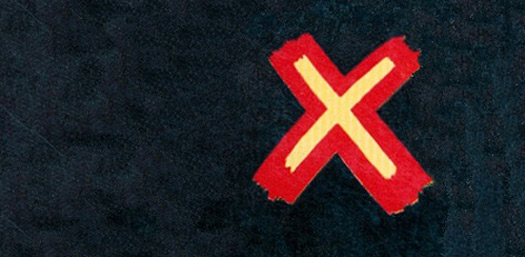
The X from the book Warrant for X (1945; first pub. 1938 as The Nursemaid Who Disappeared), by Philip MacDonald
I started collecting Cold War-era (i.e., from the end of WWII through détente) "X" paperbacks when I was 12 years old. From the pulp fiction pile in my grandfather's summer house in Maine, I smuggled home a 1945 Pocket Book edition of Philip MacDonald's Warrant for X. I didn't want to read it; I was obsessed with the free-standing "X" on its cover: two swipes of red paint topped by two narrower swipes of white. Thus rendered, the letterform struck me — though not in these terms — as the quintessential signifier of all things mysterious and dangerous, forbidden and sexy.
From the late Fifties through the Sixties, science fiction publishers seconded that emotion. Even as the free-standing letter "X" all but vanished from the titles of crime novels (why? all theories welcomed), it resurfaced in sci-fi novel titles, from Wilson Tucker's Tomorrow Plus X (1957) through by Theodore Sturgeon's Venus Plus X (1960), Andre Norton's The X Factor (1965), and Ben Barzman's Echo X (1968). Though I do have a couple of mysteries — and two romance novels — in my collection, the rest are science fiction.I started collecting Cold War-era (i.e., from the end of WWII through détente) "X" paperbacks when I was 12 years old. From the pulp fiction pile in my grandfather's summer house in Maine, I smuggled home a 1945 Pocket Book edition of Philip MacDonald's Warrant for X. I didn't want to read it; I was obsessed with the free-standing "X" on its cover: two swipes of red paint topped by two narrower swipes of white. Thus rendered, the letterform struck me — though not in these terms — as the quintessential signifier of all things mysterious and dangerous, forbidden and sexy.
I haven't attempted to track down copies of every single Cold War-era "X" paperback, but my research indicates that there are a couple dozen of them out there — not counting novels with non-freestanding-"X" titles like The X-machine, Phenomena X, Force 97X, or Formula 29X (all of which happen to have been penned by the same author, using various pseudonyms). If I sound like an overly uptight purist, I hasten to note that I'm not too proud to collect novels whose titles were changed: e.g., Tomorrow Plus X was first published as Time Bomb, while Echo X was originally Twinkle, Twinkle, Little Star. I can't afford to be that choosy: MacDonald's Warrant for X, the catalyst for three decades of collecting "X" books, was first published in 1938 under the "X"-less title The Nursemaid Who Disappeared!
The following slideshow features fifteen of my favorite Cold War-era "X" paperbacks. For more information on these titles and their authors, and to view more titles in my ever-expanding "X" collection, check out the pulp fiction gallery I've created at the website HiLobrow.

